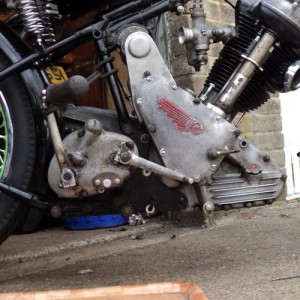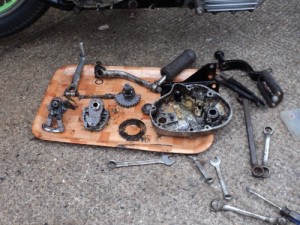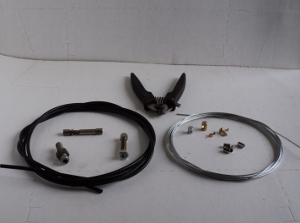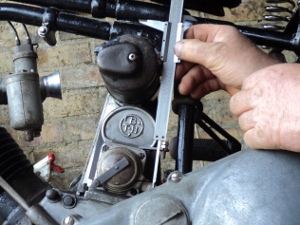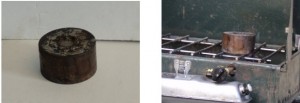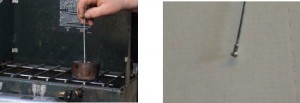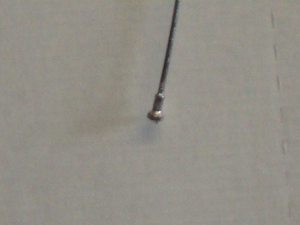I’ve known from the start that the kickstart return spring was broken, but otherwise the gearbox seemed OK, it was selecting gears and turning over in all four gears smoothly, with no roughness of feel to indicate a bad bearing.
I got a new return spring at the weekend and so went to fit it. As this is a grease-lubricated gearbox I could not just take out the drain plug and empty it before I started so I expected a bit of a mess but last night I broke the seal around the outer cover of the case and left it to drip overnight.
This was more succesful than I expected as when I took the outer case off completely this morning there wasn’t that much grease left in the ‘box and a fair bit of gloop in the catch pan, I suspect it may have been filled with a 50/50 mix of grease and oil, a not uncommon trick back in the day.
It quickly became obvious that the kickstart spring had broken, about 2 turns from its inner end, so I removed the kickstart lever from its shaft and then the quadrant from the case.
I had an old 5 litre oil can with the side cut out and with about a litre of paraffin (kerosene) in it, along with a paint brush and a couple of toothbrushes (Sainsbury’s cheapo’s at 18p a pair) and used them all to wash out the outer case.
Once I’d replaced the spring I decided to check its meshing gear and the kickstart ratchet for wear so I undid the nut on the end of the mainshaft and removed them. While doing this I noticed that the mainshaft bearing “looked wrong” and on closer examination found it was frozen, with the mainshaft turning in it, the mainshaft is intentionally a slip fit in the bearing.
Swift replan of things!, the gearbox had to be stripped.
In theory the bearing can be replaced on its own without this but it’s not a good idea to replace only one of a bearing pair, and it’s a total gearbox strip to do the drive end bearing.
According to the book you remove three nuts and the inner case will simply slide off along the studs,
So says the book but needless to say this did not happen and the inner case had to be wangled along a bit and then the gears pushed back into the main casing before the inner case could be finally wangled off.
In these Burman ‘boxes the selector camshaft runs in a crowded roller bearing in the inner case and when that case is removed the rollers promptly drop onto the floor and are lost, but I knew about this little”feature” and so had put a large cardboard tray under the gearbox to catch them as they fell.
Once the sticky mass of grease in the tray was checked through there they were, 11 little rollers, but there should be 12 of them!. So check the gearbox shells and shafts, No, check the floor, No, no sign anywhere.
So next was to take out the gears as a set, first remove the mainshaft itself through the primary chaincase, remove the indexing pawl from against the camshaft and the whole cluster just lifts out.
Check the gears, even between their teeth, still no sign of the missing roller but the gears are bright clean without any sign of corrosion and, while used are still eminently serviceable. The mainshaft shows no scuffing or other wear where it runs in the bearing at the kickstart end so it cannot have been running in the bearing, which must have frozen with standing for so long and not when last in use.
All that’s left to do is to take the shell out of the bike to replace the drive side bearing, while it is possible to do it “in situ” I want to clean the case out completely.
Easy way here is remove the rear mudguard and drop the shell out to the rear, and as I have a couple of jobs to do on the rear guard anyway it will kill two birds with one stone as it were.
On checking the lists both bearings, as well as new camshaft rollers, are available through the Panther Club so I’ll order them up.

